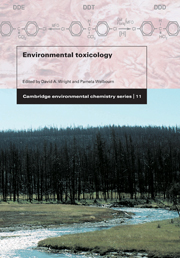Book contents
- Frontmatter
- Contents
- Foreword
- Preface
- Abbreviations
- Acknowledgements
- 1 The emergence of environmental toxicology as science
- 2 The science of environmental toxicology: Concepts and definitions
- 3 Routes and kinetics of toxicant uptake
- 4 Methodological approaches
- 5 Factors affecting toxicity
- 6 Metals and other inorganic chemicals
- 7 Organic compounds
- 8 Ionising radiation
- 9 Complex issues
- 10 Risk assessment
- 11 Recovery, rehabilitation, and reclamation
- 12 Regulatory toxicology
- 13 An overall perspective, or where to from here?
- Glossary
- Index
2 - The science of environmental toxicology: Concepts and definitions
Published online by Cambridge University Press: 05 June 2012
- Frontmatter
- Contents
- Foreword
- Preface
- Abbreviations
- Acknowledgements
- 1 The emergence of environmental toxicology as science
- 2 The science of environmental toxicology: Concepts and definitions
- 3 Routes and kinetics of toxicant uptake
- 4 Methodological approaches
- 5 Factors affecting toxicity
- 6 Metals and other inorganic chemicals
- 7 Organic compounds
- 8 Ionising radiation
- 9 Complex issues
- 10 Risk assessment
- 11 Recovery, rehabilitation, and reclamation
- 12 Regulatory toxicology
- 13 An overall perspective, or where to from here?
- Glossary
- Index
Summary
The development of environmental toxicology
An historical perspective on the science of environmental toxicology
In Chapter 1, we discussed some of the historical, social, and economic background that accompanied the development of environmental toxicology. Here, we address some of the scientific and technical aspects of the subject.
The connection between community living and human health problems has been recognised for many centuries, long before any cause-effect relationship was clearly understood. It was probably in the earliest centres of human civilisation that the first pollution control laws were enacted. Fully 2,500 years ago, Athens had a law requiring refuse disposal outside the city boundaries. Today, the disposal of “unwanted” products of humans, including sewage, domestic refuse, and industrial waste continues to occupy a large proportion of the resources of human communities, and many of the attendant problems continue to challenge environmental scientists, public health professionals, and engineers.
The development of methods for determining the impact of man on the environment has advanced on several different fronts. When assessing damage to an ecosystem, we are chiefly concerned with the route(s) of exposure of biota to toxic agents and the degree of effect. The latter will depend on the inherent toxicity of the chemical(s), their availability to sensitive segments of the ecosystem, and their persistence in the biosphere.
Toxic chemicals enter the environment through a great variety of human activities including the mining, smelting, refining, manufacture, use, and disposal of products.
- Type
- Chapter
- Information
- Environmental Toxicology , pp. 21 - 69Publisher: Cambridge University PressPrint publication year: 2002

